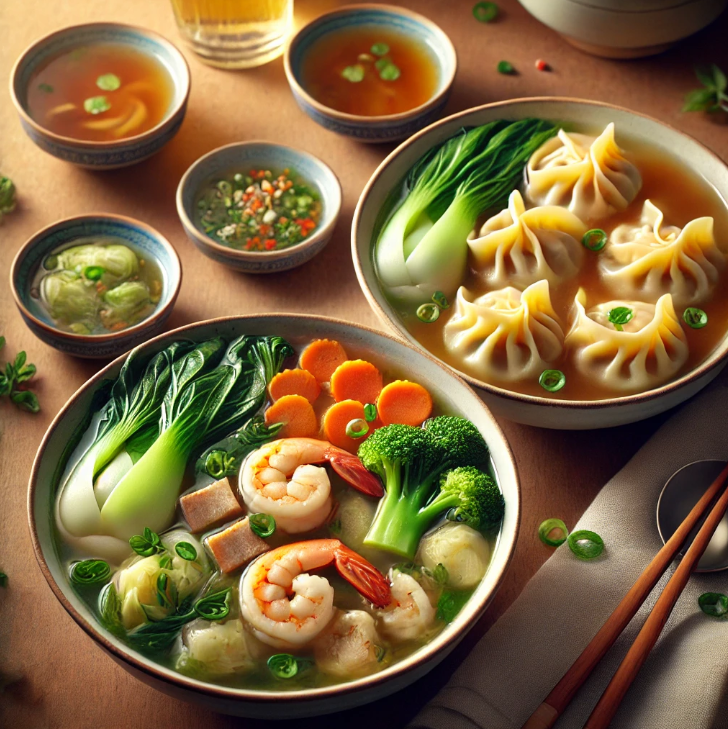Wonton soup is a classic comfort food with its delicate dumplings floating in a warm, savory broth. But have you ever wondered what sets Wor Wonton Soup apart from the traditional version? These two dishes might share a name, but they’re distinct in terms of ingredients, complexity, and nutritional profiles.
In this article, we’ll dive into the unique features of Wor Wonton Soup and Wonton Soup, exploring their differences, health benefits, and tips for making healthier versions at home. Whether you’re a fan of the minimalist simplicity of wonton soup or prefer the hearty, loaded version of wor wonton soup, you’ll discover everything you need to know about these two beloved dishes.
Table of Contents
What Are Wor Wonton Soup and Wonton Soup?
A Simple Overview of Wonton Soup
At its core, it is a traditional Chinese dish featuring wontons—small dumplings filled with seasoned meat or shrimp—served in a clear broth. The simplicity of this dish is its charm, relying on high-quality ingredients to deliver bold flavors.
The wontons are typically made with thin wrappers filled with ground pork, shrimp, or a combination of both. The broth is light and flavorful, often enhanced with scallions, ginger, and a drizzle of sesame oil. This minimalist approach makes it a go-to for anyone craving a comforting and easy-to-digest meal.
The Evolution of Wor Wonton Soup
On the other hand, it takes the simplicity of it and turns it into a full-fledged meal. The word “wor” means “everything” or “loaded,” and this soup lives up to its name. In addition to wontons, this dish includes a variety of proteins like chicken, shrimp, and roast pork, along with a medley of colorful vegetables such as bok choy, carrots, and mushrooms.
The result is a hearty, nutrient-rich soup that offers a balanced mix of flavors and textures. While the traditional soup is often considered a starter, it is substantial enough to serve as a main course. Its versatility and vibrant ingredients make it a popular choice for both restaurants and home kitchens.
Key Differences Between Wor Wonton Soup and Wonton Soup
Ingredients That Set Them Apart
When comparing Wor Wonton Soup and Wonton Soup?, the most noticeable difference lies in the ingredients. Traditional wonton soup keeps it simple with wontons as the centerpiece, accompanied by a flavorful broth and minimal garnishes like scallions or sesame oil.
In contrast, Wor Wonton Soup is a loaded version that includes a variety of proteins, such as chicken, shrimp, and pork, alongside an array of fresh vegetables like bok choy, carrots, mushrooms, and snap peas. This enhanced ingredient list not only makes wor wonton soup heartier but also more nutrient-rich.
Flavor Profiles and Complexity
The flavor profile of traditional wonton soup is light and straightforward, allowing the savory broth and tender wontons to shine. It’s an ideal choice for those who enjoy clean, uncomplicated flavors.
On the other hand, Wor Wonton Soup delivers a more complex flavor experience. With the addition of multiple proteins and vegetables, each bite offers a mix of textures and tastes, from the umami-rich roast pork to the crisp sweetness of fresh veggies. The broth also tends to have a deeper flavor, often infused with ginger, garlic, and soy sauce for added depth.
Traditional Presentation and Variations
It is typically served as a starter in small bowls, emphasizing its simplicity and elegance. The wontons are neatly arranged in the broth, making it a visually appealing yet modest dish.
Meanwhile, Wor Wonton Soup is served as a main course in larger bowls, showcasing its vibrant array of ingredients. This soup is highly customizable, with restaurants and home cooks often adding their own twists, such as spicy chili oil or different vegetable combinations, to suit individual preferences.
Nutritional Profiles of Both Soups
Calorie Counts and Macronutrients
When considering their nutritional aspects, calorie count is a significant factor. A typical serving of traditional one contains around 150–250 calories, making it a light and low-calorie option. The bulk of these calories come from the wontons, which provide carbs and protein, and the broth, which is usually low in fat.
On the other hand, Wor Wonton Soup is more calorie-dense due to its additional proteins and vegetables. A serving can range from 250–400 calories, depending on portion size and ingredients. While it’s higher in calories, it also offers more balanced macronutrients, including protein, fiber, and healthy fats.
Vitamins and Minerals in Each Version
It provides some essential nutrients. The broth is a source of hydration and electrolytes, while the wontons contribute protein and small amounts of iron. However, its lack of vegetables means it doesn’t offer much in terms of vitamins or fiber.
In contrast, Wor Wonton Soup shines as a nutrient powerhouse. The inclusion of bok choy, carrots, and mushrooms adds vitamins A, C, and K, as well as potassium and antioxidants. The variety of proteins also boosts its iron and zinc content, making it a more well-rounded meal option.
Sodium Content and Its Impact on Health
Both versions of it can be high in sodium, especially if made with store-bought broths or soy sauce. A single serving may contain 800–1,200 milligrams of sodium, which can quickly add up if consumed regularly.
To keep sodium levels in check, opt for low-sodium broth or homemade stock. Reducing the amount of soy sauce and seasoning with fresh herbs instead can also help make these soups a healthier choice.
For a detailed recipe to prepare this dish, you can refer to a traditional dumpling soup guide, which outlines every step.
Health Benefits of Wonton-Based Soups
Digestive Benefits of Clear Broth Soups
Both of them share a common base: clear broth. This light, hydrating liquid is not only soothing but also easy on the stomach, making it ideal for those with digestive sensitivities. The broth often contains ginger and garlic, two ingredients known for their anti-inflammatory and digestive-boosting properties.
In addition, the warmth of the soup helps to relax the digestive tract, while the simplicity of its ingredients makes it a go-to choice for anyone recovering from illness or looking for a low-fat meal option.
Protein Sources and Nutritional Contributions
The protein sources in both play a significant role in their health benefits. Traditional wonton soup relies on ground pork or shrimp-filled dumplings for its protein, while wor wonton soup takes it further by adding chicken, shrimp, and sometimes roast pork.
Protein is essential for muscle repair, hormone production, and overall energy. The inclusion of shrimp adds a low-calorie yet nutrient-dense option, offering selenium and vitamin B12. For those looking to increase their protein intake without consuming excess calories, these soups are a perfect choice.
The Role of Vegetables in Wor Wonton Soup
While the traditional one is relatively minimalist, it is loaded with vegetables like bok choy, mushrooms, and carrots. These vegetables not only add color and texture but also significantly boost the nutritional profile of the dish.
Carrots and bok choy provide vitamin A for improved vision and immune function, while mushrooms deliver antioxidants that protect against free radicals. Incorporating a variety of vegetables ensures that Wor Wonton Soup is as nourishing as it is satisfying.
If you enjoy experimenting with soups, you might also like this comforting chicken noodle recipe with a twist.
How to Make Healthier Versions of Both Soups
Substituting Low-Sodium Ingredients
One of the easiest ways to make them healthier is to start with a low-sodium broth. Store-bought broths can contain excessive sodium, so opting for a homemade version or choosing a reduced-sodium option can significantly lower the salt content.
Additionally, using fresh herbs and spices like ginger, cilantro, or star anise can add flavor without relying on salt. These small changes can make a big difference, especially for those managing blood pressure or heart health.
Increasing Vegetable Ratios for Balance
For a nutrient-packed bowl, consider increasing the ratio of vegetables to wontons. Adding extra bok choy, snap peas, or spinach can enhance the soup’s fiber and vitamin content while keeping it light and low in calories.
This simple tweak not only improves the soup’s nutritional value but also stretches the serving size, making it a more filling meal without adding significant calories or carbs.
Gluten-Free and Plant-Based Adaptations
If you’re wondering how to make them suitable for specific diets, there are plenty of options. For gluten-free versions, use rice paper wrappers for the wontons or substitute with thinly sliced vegetables like zucchini.
For a plant-based twist, replace traditional pork or shrimp fillings with a mixture of tofu, mushrooms, and seasonings. This ensures that the soup remains high in protein and flavor, while catering to vegetarian and vegan diets.
Internal Linking Suggestion
For a detailed recipe on creating your own homemade wontons, check out this Easy Wor Wonton Soup Recipe on Recipes to Explore. It’s a great guide for preparing both traditional and modern versions of this beloved dish.
The Final Verdict on Wor Wonton Soup and Wonton Soup
When to Choose Wonton Soup
It is an excellent choice if you’re craving a light, comforting dish that’s easy on the palate. Its simple combination of wontons and broth makes it perfect as a starter or a quick meal. For those watching their calorie intake or seeking a low-sodium option, it is the way to go—especially when prepared with lean proteins and a homemade broth.
This dish is also ideal for moments when you want a straightforward, no-fuss soup that still delivers on flavor. It’s a great option for those recovering from illness or simply looking for something warm and nourishing.
When to Opt for Wor Wonton Soup
On the other hand, it is best when you’re looking for a hearty, nutrient-packed meal in one bowl. Its variety of proteins and vegetables provides a balanced mix of macronutrients and essential vitamins, making it a complete meal rather than a side dish.
For families or gatherings, wor wonton soup’s customizable nature allows everyone to enjoy their preferred ingredients, making it a crowd-pleaser. If you’re hosting or preparing a meal for special occasions, this soup stands out as a flavorful and filling choice.
For another wholesome meal, consider this recipe for a nutrient-packed stir-fry, which pairs protein with fresh vegetables.
Tips for Enjoying Wor Wonton Soup and Wonton Soup Mindfully
Experimenting with Ingredients for Healthier Options
One of their most enjoyable aspects is how easily they can be tailored to suit your preferences. To make the soups healthier, try incorporating these tweaks:
- Add More Veggies: Boost the fiber and vitamin content by adding extra bok choy, carrots, spinach, or mushrooms.
- Choose Lean Proteins: Swap pork for chicken breast, shrimp, or tofu to reduce fat while maintaining protein levels.
- Use Low-Sodium Alternatives: Opt for low-sodium broth and reduce the amount of soy sauce to control sodium intake.
By experimenting with different ingredients, you can create a version of these soups that aligns with your dietary goals while still tasting delicious.
Making These Soups a Balanced Meal
To ensure that they fit into a balanced diet, consider pairing them with complementary dishes. For example, serve wonton soup as an appetizer alongside a main course of grilled chicken or fish and steamed vegetables.
For wor wonton soup, which is already hearty, you might add a side of whole-grain rice or a light salad to complete the meal. These thoughtful additions ensure you’re enjoying a well-rounded and satisfying dining experience.
For more recipes and tips on making delicious Wor Wonton Soup and Wonton Soup at home, visit Food.com. Their step-by-step guides and creative ingredient suggestions can help you perfect these comforting dishes!


